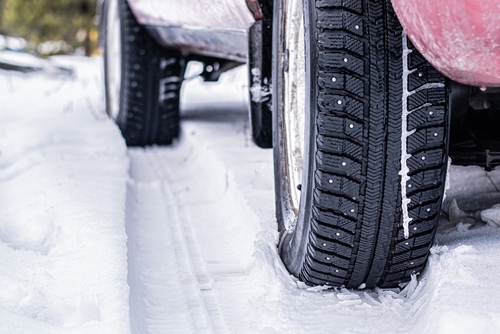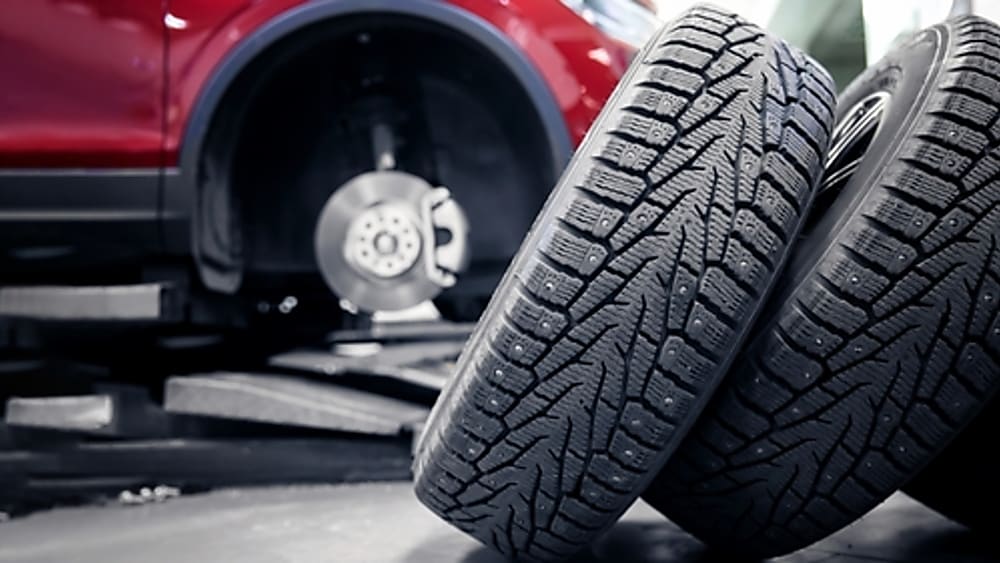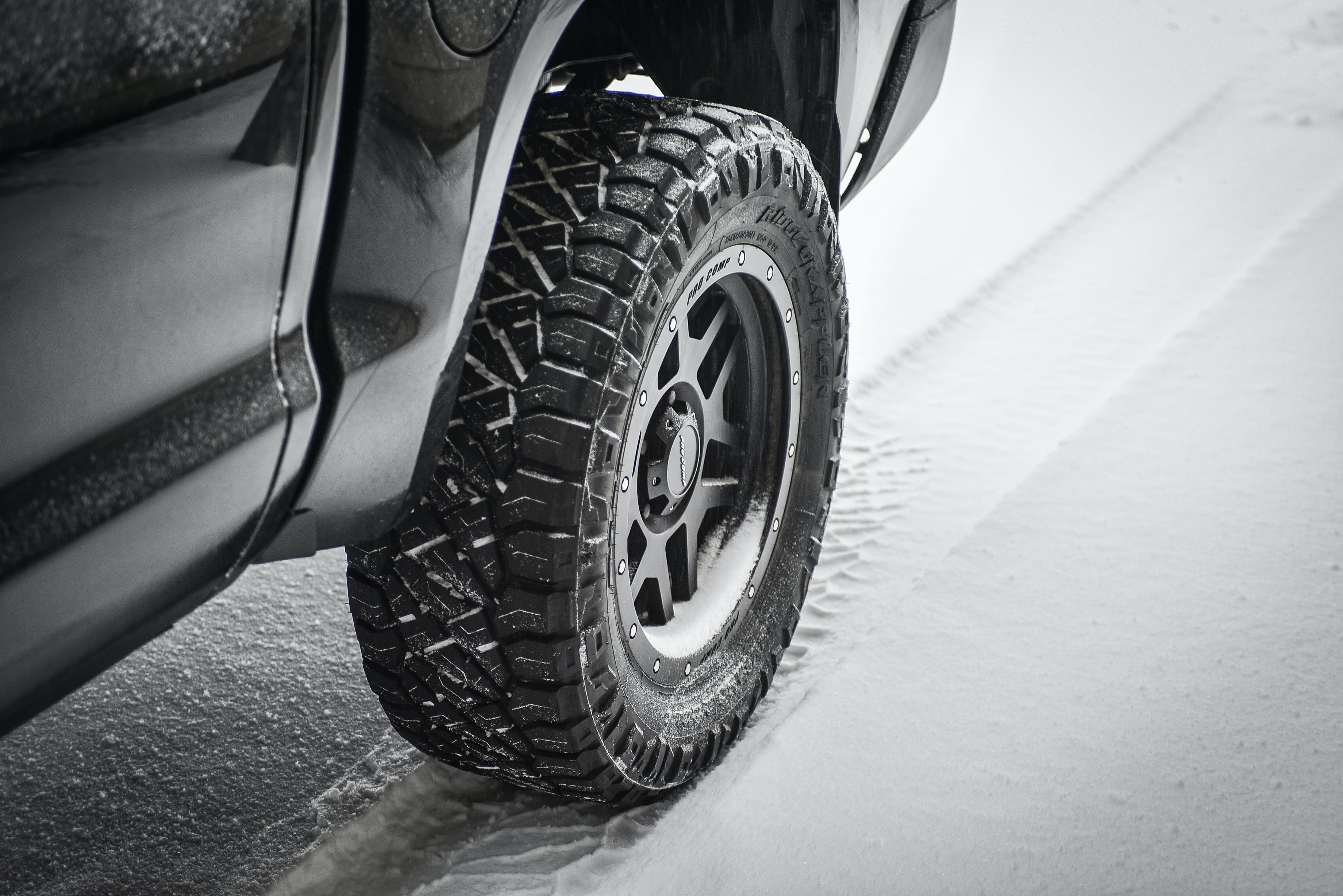Tire Buying Guides
Winter Tires vs. All-Season: Your Guide to Cold Weather Safety

Free shipping
Best price guarantee
SimpleCrew exclusive savings
0% financing options
Tire replacement coverage
24/7 roadside assistance
Easy returns
Tire Buying Guides

Winter weather demands more from your tires than any other season. Cold temperatures, snow, ice, and slush create hazardous conditions that standard tires struggle to handle safely.
Many drivers believe their all-season tires provide adequate protection year-round. This misconception leads to thousands of preventable accidents each winter when vehicles lose traction on cold, slippery roads.
The decision to invest in winter tires affects more than just your safety. Insurance rates, legal compliance, and even your vehicle's overall performance depend on having the right tires for winter conditions.

Winter tires represent a significant advancement in automotive safety technology. These specialized tires utilize rubber compounds engineered to remain flexible when temperatures drop below 45°F — the point at which standard tires begin to harden and lose grip. Unlike all-season tires that prioritize longevity, winter tires focus exclusively on cold-weather performance.
The most distinctive feature of winter tires lies in their tread design. Manufacturers cut thousands of tiny slits called sipes into the tread blocks. These sipes act like miniature edges that bite into ice and packed snow. The tread patterns also feature deeper grooves specifically shaped to channel water, slush, and loose snow away from the tire's contact patch. This aggressive design prevents hydroplaning and maintains road contact even in severe conditions.
Winter tires must meet strict performance standards to earn certification. The Three-Peak Mountain Snowflake symbol indicates a tire has passed industry tests for snow traction — requirements that all-season tires rarely achieve. Brands like Nokian, Continental, and Bridgestone invest millions in research to develop compounds and tread patterns that maximize winter performance while maintaining acceptable wear rates.
The physics of tire performance revolves around temperature thresholds. Every tire compound has a glass transition temperature, the point at which rubber transforms from flexible to rigid. Summer tires reach this threshold around 50°F, while winter tire compounds remain pliable well below freezing. This flexibility allows the tire to conform to road irregularities and maintain crucial grip.
Winter tire engineers exploit an interesting property of snow: its tendency to stick to itself. The deep grooves and sipes in winter tires pack snow into the tread pattern. This packed snow then grips the snow on the road surface — similar to how a snowball sticks together. Continental's winter tire development team specifically designs tread blocks to optimize this snow-on-snow adhesion principle.
Temperature affects more than just rubber flexibility. Cold air causes tire pressure to drop approximately one PSI for every 10°F decrease in temperature. Winter tires compensate for this with construction techniques that maintain proper contact patch shape even with pressure variations. The specialized rubber compounds also generate more heat through flexing, which helps maintain optimal operating temperature in cold conditions that would leave all-season tires dangerously rigid.
All-season tires aim for versatility across different weather conditions, yet this leads to trade-offs. Often perceived as suitable for most of the year, these tires struggle when temperatures fall. Their rubber formulas become less effective in gripping the road as it gets colder. While all-season tires adhere to basic safety criteria, they do not meet the stringent requirements necessary for winter driving effectiveness.
The emphasis on durability in all-season tires often comes at the expense of the traction required for safe winter travel. These tires are built to withstand wear through various seasons, but this durability does not extend to icy or snowy conditions. The regulatory standards for all-season tires do not demand the same level of performance on wintry surfaces as those set for winter tires. This discrepancy can lead to an increased risk of losing control in adverse weather, underscoring the essential function of tires designed specifically for winter.
All-season tires show varying levels of performance in cold climates. Some models operate more like summer tires, providing limited security in snow-covered settings. The focus on tread life often limits their ability to perform effectively in cold conditions. Even the top all-season tires cannot replicate the ice traction and stopping power of winter tires.
Drivers who rely on all-season tires face a higher likelihood of sliding and longer stopping distances. Winter tires, crafted with unique materials and tread designs, provide the confidence necessary for navigating challenging winter roads. This contrast highlights the critical need to select tires based on your specific climate and driving requirements.

Winter tires significantly enhance vehicle safety and handling in challenging conditions. Their specialized rubber compounds and tread patterns enable more reliable traction on icy, snowy, or wet roads. This design feature allows vehicles to come to a stop more swiftly, minimizing the chances of collisions. Improved grip also translates to better steering accuracy, enabling smoother navigation through turns even during harsh winter weather. Drivers experience more predictable vehicle behavior, fostering a heightened sense of confidence when driving on winter roads.
The role of winter tires in maintaining road safety extends to emergencies. Their superior grip reduces the risk of sliding or losing control during sudden maneuvers. This capability is crucial when every inch of stopping distance can prevent an accident. The assurance that comes from equipping your vehicle with winter tires contributes significantly to overall driving safety and peace of mind.
Winter tires offer long-term value that benefits drivers throughout the entire year. By using winter tires during colder months, the lifespan of your all-season or summer tires is extended, as each tire type is utilized in the conditions it was designed for. This strategic tire rotation maximizes performance and durability. Furthermore, many insurance providers acknowledge the enhanced safety of winter tires, often resulting in premium discounts for users, adding a financial benefit to the safety advantages.
The use of winter tires also alleviates the strain on your vehicle's components. With better traction, there is less stress on the drivetrain and suspension, as the tires maintain grip more effectively during acceleration and braking. This stress reduction can lead to fewer repairs and maintenance needs over time. Additionally, having the right tires for unpredictable winter conditions offers peace of mind, allowing drivers to focus on the journey without concern for tire performance.

Timing your switch to winter tires centers around consistent temperature drops rather than the arrival of snow. Once temperatures consistently fall below 45°F, it's time to replace your summer or all-season tires with winter ones. Cold conditions alone can affect tire grip, even if roads seem clear. Shifting to winter tires in advance of severe weather ensures your vehicle is prepared for the challenges of icy or wet roads.
Consider transitioning to winter tires in mid-to-late fall. This early preparation allows you to avoid the rush and ensures your vehicle is ready for winter conditions before they become hazardous. When spring arrives and temperatures stabilize above 45°F, switch back to your summer or all-season tires. This timely change optimizes the lifespan of your winter tires, maintaining their effectiveness for another season.
Your geographical location significantly influences when to install winter tires. In areas with long, harsh winters, such as northern states, using winter tires from November through March is advisable. Mountainous regions, with their higher altitudes, may require an earlier installation due to the earlier onset of cold. Residents in these areas should monitor local weather forecasts closely to adjust their tire change schedule accordingly.
In coastal areas, where winters are generally milder, winter tires still offer benefits during occasional cold snaps. Keeping an eye on local weather patterns and planning tire changes based on forecasted conditions ensures readiness for any unexpected winter weather. Being proactive and aware of regional climate nuances enhances driving safety throughout the colder months.
Winter tire requirements differ greatly across regions. In areas with harsh winter climates, authorities often impose specific regulations to enhance road safety. In the United States, certain states require drivers to use winter tires or chains on specific mountain passes where severe weather is frequent. These laws aim to ensure that vehicles maintain adequate traction on slippery, steep roads. To stay informed and compliant, it’s crucial to consult your local Department of Transportation for detailed requirements applicable to your area. Such knowledge not only keeps you within legal bounds but also enhances your safety and that of fellow travelers.
Equipping your vehicle with winter tires can influence your insurance policy in meaningful ways. Recognizing the added safety provided by winter tires, many insurance providers offer premium discounts to drivers who fit their vehicles with these tires during the colder months. This discount is a testament to the lower risk of accidents when vehicles have tires suited for winter driving conditions.
Conversely, neglecting to use appropriate seasonal tires could potentially impact your insurance claims. Some insurance companies might refuse claims if an accident occurs and the vehicle is not fitted with proper winter tires, viewing this as a lapse in responsible vehicle maintenance. To safeguard against such issues, it’s advisable to keep a record of your winter tire installations, providing evidence of your commitment to vehicle safety. This documentation can verify your careful approach to driving during winter, supporting your diligence in maintaining road safety.
All-wheel-drive (AWD) systems excel in distributing power to all wheels, enhancing acceleration on slick surfaces. However, this advantage does not extend to braking or cornering capabilities. It's a common belief that AWD vehicles can forgo winter tires, yet this can lead to dangerous overconfidence. Winter tires remain essential for providing the grip needed for safe stopping and turning, which AWD alone cannot address. Without them, an AWD vehicle may still face challenges in maintaining control on icy or snowy roads.
While AWD helps with traction, it doesn't tackle the core issues posed by winter conditions. Drivers of AWD vehicles, confident in their system's prowess, might overlook the necessity of winter tires. In reality, a 2WD vehicle with winter tires can surpass an AWD vehicle equipped with all-season tires in harsh winter settings. By pairing the traction benefits of AWD with the specialized grip of winter tires, drivers experience comprehensive safety and performance enhancements on winter roads.
The science behind safe winter driving underscores the critical role of tire contact with the road surface. Each vehicle, regardless of its drivetrain, depends on four points of contact where the tire meets the pavement. These contact points are vital for effective stopping and turning, relying heavily on the tire's ability to maintain traction.
AWD systems provide improved power distribution but do not influence these essential aspects of driving physics. The grip that winter tires offer ensures stability and responsiveness, even in challenging winter climates. Without proper tire grip, even advanced AWD systems cannot overcome the natural limitations posed by ice or snow.
Recognizing the constraints of AWD emphasizes the importance of considering winter tires as a key component of vehicle safety. They are not merely an enhancement but a necessary part of ensuring optimal performance during the winter months. By fitting vehicles with winter tires, drivers can maximize their AWD systems' effectiveness, achieving a balanced and secure driving experience in winter conditions.

Choosing the right winter tire requires a focus on several key attributes that guarantee your safety on the road. The Three-Peak Mountain Snowflake emblem is a critical marker, indicating that the tire meets stringent criteria for snow traction, ensuring reliability in snowy and icy conditions. This designation confirms that the tire is equipped to handle severe weather, making it an essential consideration for those navigating harsh winter environments.
Assessing your typical winter driving conditions is vital. If you regularly encounter icy roads, packed snow, or slush, prioritize tires with innovative tread designs and extensive siping. These characteristics enhance traction and efficiently disperse water and slush, minimizing hydroplaning risks. For those covering extensive distances, paying attention to treadwear ratings ensures the tires can endure high mileage without sacrificing performance or safety.
Winter tires are available in several variations, each suited to different driving needs and environmental challenges. Studless ice and snow tires are lauded for their adaptability and effectiveness across diverse winter scenarios. They incorporate advanced rubber formulations and tread patterns to deliver superior grip on both ice and snow, eliminating the need for metal studs—a feature that makes them ideal for drivers facing varied winter conditions.
Drivers seeking a combination of high performance and winter capability might consider performance winter tires. These tires strike a balance between excellent cold-weather traction and agile handling, catering to high-performance vehicles that demand precision. In regions where icy roads are a constant challenge, studded tires might be necessary. These tires feature metal studs for exceptional ice traction but may be restricted by law in certain areas.
For those residing in regions with milder winters, all-weather tires offer a practical compromise. While they don't match the extreme ice and snow protection of dedicated winter tires, they provide reasonable safety and performance for areas with less severe winter conditions. These tires offer convenience by eliminating the need for seasonal tire changes, making them suitable for drivers who experience occasional cold spells rather than prolonged winter weather.

Properly installing your winter tires ensures your vehicle performs safely and efficiently during the colder months. Always fit them in complete sets of four to guarantee uniform traction and handling. An unbalanced setup can lead to erratic vehicle control, especially on slippery winter roads.
Cold temperatures can cause tire pressure to decrease, so a monthly pressure check is essential. Keeping tires inflated to the recommended levels ensures consistent contact with the road, which is critical for maintaining grip and fuel efficiency.
Rotating winter tires according to the manufacturer’s schedule helps prevent uneven wear, extending their functional lifespan. When the season ends, store your tires in a place that's cool and away from sunlight to protect them from environmental damage. This storage practice preserves the integrity of the rubber, ensuring your tires are ready for the next winter season.
Purchasing winter tires during off-peak times can lead to substantial savings. Retailers often offer better deals on tire purchases outside of the winter season. Investing in an extra set of wheels specifically for your winter tires can streamline the seasonal changeover process. This setup not only makes the switch easier but also reduces wear on the tires, enhancing their longevity.
By performing regular maintenance, you can extend the life of your winter tires to several seasons. Regular checks and appropriate care keep them in optimal working condition. When calculating the cost, consider the expense spread over the life of the tires, rather than just the initial outlay. This perspective helps highlight the long-term benefits and safety advantages that winter tires provide, ensuring peace of mind across multiple winters.
Winter driving demands the right equipment, and your tires are the most critical safety component between you and the road. The investment in proper winter tires pays dividends through improved safety, better vehicle control, and potential insurance savings that make the decision clear for anyone facing cold weather conditions.
Ready to find the perfect winter tires for your vehicle? We make it easy to shop for tires online and find the best deals with our extensive selection and expert guidance to help you drive confidently all winter long.
Search By